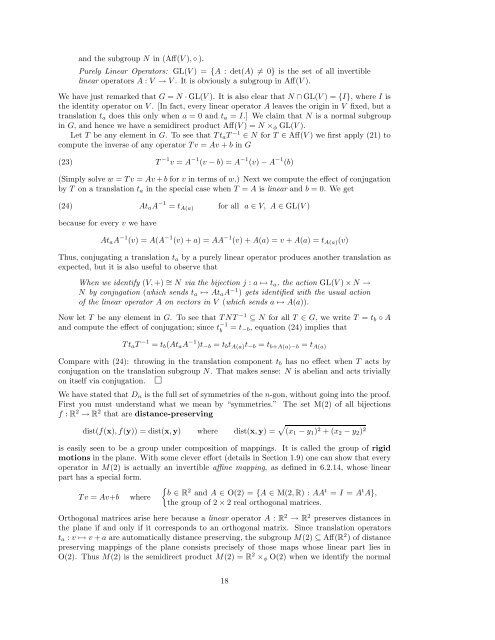Algebra I: Section 6. The structure of groups. 6.1 Direct products of ...
Algebra I: Section 6. The structure of groups. 6.1 Direct products of ...
Algebra I: Section 6. The structure of groups. 6.1 Direct products of ...
Create successful ePaper yourself
Turn your PDF publications into a flip-book with our unique Google optimized e-Paper software.
and the subgroup N in (Aff(V ), ◦ ).<br />
Purely Linear Operators: GL(V ) = {A : det(A) �= 0} is the set <strong>of</strong> all invertible<br />
linear operators A : V → V . It is obviously a subgroup in Aff(V ).<br />
We have just remarked that G = N · GL(V ). It is also clear that N ∩ GL(V ) = {I}, where I is<br />
the identity operator on V . [In fact, every linear operator A leaves the origin in V fixed, but a<br />
translation ta does this only when a = 0 and ta = I.] We claim that N is a normal subgroup<br />
in G, and hence we have a semidirect product Aff(V ) = N ×φ GL(V ).<br />
Let T be any element in G. To see that TtaT −1 ∈ N for T ∈ Aff(V ) we first apply (21) to<br />
compute the inverse <strong>of</strong> any operator Tv = Av + b in G<br />
(23) T −1 v = A −1 (v − b) = A −1 (v) − A −1 (b)<br />
(Simply solve w = Tv = Av +b for v in terms <strong>of</strong> w.) Next we compute the effect <strong>of</strong> conjugation<br />
by T on a translation ta in the special case when T = A is linear and b = 0. We get<br />
(24) AtaA −1 = t A(a) for all a ∈ V, A ∈ GL(V )<br />
because for every v we have<br />
AtaA −1 (v) = A(A −1 (v) + a) = AA −1 (v) + A(a) = v + A(a) = t A(a)(v)<br />
Thus, conjugating a translation ta by a purely linear operator produces another translation as<br />
expected, but it is also useful to observe that<br />
When we identify (V, +) ∼ = N via the bijection j : a ↦→ ta, the action GL(V ) × N →<br />
N by conjugation (which sends ta ↦→ AtaA −1 ) gets identified with the usual action<br />
<strong>of</strong> the linear operator A on vectors in V (which sends a ↦→ A(a)).<br />
Now let T be any element in G. To see that TNT −1 ⊆ N for all T ∈ G, we write T = tb ◦ A<br />
and compute the effect <strong>of</strong> conjugation; since t −1<br />
b = t−b, equation (24) implies that<br />
TtaT −1 = tb(AtaA −1 )t−b = tbt A(a)t−b = t b+A(a)−b = t A(a)<br />
Compare with (24): throwing in the translation component tb has no effect when T acts by<br />
conjugation on the translation subgroup N. That makes sense: N is abelian and acts trivially<br />
on itself via conjugation. �<br />
We have stated that Dn is the full set <strong>of</strong> symmetries <strong>of</strong> the n-gon, without going into the pro<strong>of</strong>.<br />
First you must understand what we mean by “symmetries.” <strong>The</strong> set M(2) <strong>of</strong> all bijections<br />
f : R 2 → R 2 that are distance-preserving<br />
dist(f(x), f(y)) = dist(x,y) where dist(x,y) = � (x1 − y1) 2 + (x2 − y2) 2<br />
is easily seen to be a group under composition <strong>of</strong> mappings. It is called the group <strong>of</strong> rigid<br />
motions in the plane. With some clever effort (details in <strong>Section</strong> 1.9) one can show that every<br />
operator in M(2) is actually an invertible affine mapping, as defined in <strong>6.</strong>2.14, whose linear<br />
part has a special form.<br />
Tv = Av+b where<br />
� b ∈ R 2 and A ∈ O(2) = {A ∈ M(2, R) : AA t = I = A t A},<br />
the group <strong>of</strong> 2 × 2 real orthogonal matrices.<br />
Orthogonal matrices arise here because a linear operator A : R 2 → R 2 preserves distances in<br />
the plane if and only if it corresponds to an orthogonal matrix. Since translation operators<br />
ta : v ↦→ v + a are automatically distance preserving, the subgroup M(2) ⊆ Aff(R 2 ) <strong>of</strong> distance<br />
preserving mappings <strong>of</strong> the plane consists precisely <strong>of</strong> those maps whose linear part lies in<br />
O(2). Thus M(2) is the semidirect product M(2) = R 2 ×φ O(2) when we identify the normal<br />
18

















